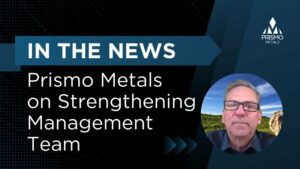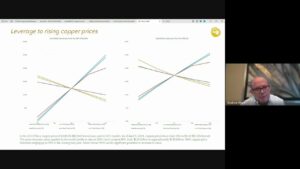VANCOUVER, BRITISH COLUMBIA – Timmins Gold Corp. (TSX:TMM) has published the following open letter to the shareholders of Capital Gold Corporation in response to recent statements by the Board of Directors of Capital Gold.
Dear Capital Gold Shareholder:
The Board of Directors of Capital Gold has made various unsubstantiated statements about the comparative attributes of the Timmins proposal versus the Gammon Gold deal.
The Capital Gold Board of Directors argues that Gammon offers a better deal than Timmins. It’s time to take a hard look at the facts.
Yesterday Gammon released its consolidated financial statements for the fiscal year ended December 31, 2010. Timmins recommends that Capital Gold shareholders take a close look at Gammon’s results.
| IF GAMMON HAS HAD A RECORD YEAR |
| WHY IS IT NOT ADDING TO ITS CASH POSITION? |
Balance Sheet Strength?
Gammon’s cash on hand represents the remaining proceeds of a US$115 million private placement Gammon completed in October 2009. At the end of that quarter, December 31, 2009, Gammon reported that it had US$128 million of cash on hand. As of the end of this latest quarter, December 31, 2010, Gammon had only US$113 million of cash on hand. Gammon’s cash has actually declined by 12% over the last fiscal year despite record gold and silver prices over the same period and despite the fact that it benefited from US$8.3 million of cash proceeds from the exercise of stock options. A closer look reveals that as of December 31, 2010, Gammon’s payables exceeded receivables by US$34 million and that Gammon had long term debt of US$27 million. When you combine these liabilities with the US$66 million cash component of Gammon’s proposal to acquire Capital Gold, Gammon’s net cash position – if it succeeded in acquiring Capital Gold – would be negative US$14 million. Gammon has also budgeted US$45 million for exploration in 2011. Based on Gammon’s disclosure, it appears that Gammon will use all of its existing cash and will either need to raise more equity or borrow heavily to meet its current obligations, fund its planned capital expenditures, and close a transaction with Capital Gold.
Incurring negative or nominal free cash flow is not a new occurrence for Gammon. In addition to the negative free cash flow of ($9.6 million) reported in 2010, Gammon reported positive free cash flow of $1.4 million in 2009 and negative ($10.9 million) in 2008.
In addition to what Gammon has disclosed, there are a number of unknowns that Gammon has still not disclosed. For example, Gammon has not disclosed any estimate for restarting operations at its El Cubo mine. But look what Macquarie Equities Research had to say on February 24, 2011: “The restart of the El Cubo Mine will encompass several one-time charges including collective bargaining charges and severance payments, which will likely be realized in Q410.”
Gammon has also not accrued any charge for a potential judgment in the ongoing class action lawsuit in Ontario which claims damages for “Reckless Misrepresentation” in connection with Gammon’s C$20 per share, C$200 million bought deal in April 2007. The claim for damages, while not proven, alleges that “as a result of the defendants’ misrepresentations … Class Members purchased Gammon shares pursuant to the Prospectus at substantially inflated prices, and sustained losses when Gammon belatedly disclosed the truth.” Note 14 to Gammon’s December 31, 2010 financial statements also states: “In July 2008 the claim was amended to, among other things, assert new claims and increase the damages sought from $80 million to $160 million. Management is of the opinion that the claim is without merit and that a strong defence exists against the claim. Therefore, no provision for loss has been reflected in the accounts of the Company.”
Do you share the opinion of management?
Strong Management Team with Operating Track Record?
Look closely at the following table from Gammon’s MD&A for the year ended December 31, 2011.
2010 Annual Management’s Discussion and Analysis:
| OCAMPO OPEN PIT | ||||
| QUARTER ENDED | YEAR ENDED | |||
| December 31, 2010 | December 31, 2009 | December 31, 2010 | December 31, 2009 | |
| Total tonnes mined | 9,727,848 | 8,040,460 | 35,562,497 | 31,639,446 |
| Total tonnes mined per day | 105,737 | 87,396 | 100,171 | 86,682 |
| Tonnes of ore mined | 975,472 | 670,211 | 3,621,308 | 2,727,231 |
| Capitalized stripping and other tonnes | 7,362,074 | 6,357,614 | 26,226,784 | 22,910,561 |
| Operating stripping ratio | 1.42 | 1.51 | 1.85 | 2.20 |
| Average grade of gold (1) | 0.53 | 0.96 | 0.54 | 1.13 |
| Average grade of silver (1) | 27 | 55 | 30 | 55 |
| Average grade of gold equivalent (1) | 1.06 | 1.85 | 1.04 | 1.96 |
| Average grade of gold equivalent (55:1) (1) (2) | 1.03 | 1.96 | 1.09 | 2.12 |
| (1) Grams per tonne. |
| (2)Average grade of gold equivalent includes silver grades converted to a gold equivalent, based on the Company’s long-term gold equivalency ratio of 55:1. |
The cash costs reported by Gammon are lowered by the stripping and related costs Gammon is capitalizing (rather than expensing as a cash cost of production). Mining operations at the Ocampo open pit required capitalized stripping costs of US$27 million in fiscal 2010 bringing the total capitalized stripping cost to $50.7 million. In 2010, Gammon mined a total of 36.5 million tonnes of material which contained only 3.6 million tonnes of ore. Combining capitalized and non-capitalized stripping would result in a strip ratio of at least 9 to 1. Timmins believes that the cost of sending 9 out of every 10 trucks to the waste dumps has contributed significantly to Gammon’s declining cash balance. Further, stripping has intensified even as Gammon mines lower grade ore. In the first quarter of 2009, 3.7 million tonnes of stripping were capitalized to produce 36,829 ounces of gold and 1,351,300 ounces of silver. By the fourth quarter of 2010, 7.4 million tonnes of stripping were capitalized to produce 29,384 ounces of gold and 1,199,829 ounces of silver.
Adding the Gammon 2010 production cost of $90 million to the capitalized stripping of $27 million produces a total cost of $118 million. The total ounces produced from operations at Ocampo in 2010 were 176,458 gold equivalent ounces. Total costs of $118 million divided by the 176,458 gold equivalent ounces produced in 2010 suggests that Gammon’s costs were $669 per gold equivalent ounce.
Combined tonnes of ore from the open pit and underground operations at Ocampo were 4,182,349 tonnes. Total costs of $118 million divided by the total tonnes of ore processed suggests that Gammon’s cost per tonne was $28.23.
The questions that Capital Gold management and shareholders should be asking are: “How and when will Gammon bring its significant capitalized stripping back into cash costs?” and “If the stripping is being capitalized why has it continued for the last two years?” and “Why have the average grades at the pit been cut almost in half in the last year from 1.96 g/t gold equivalent to 1.04 g/t gold equivalent and reduced from 4.95 g/t gold equivalent to 4.70 g/t gold equivalent underground?”
Operating Synergies?
Gammon Gold does not have current operations in Northern Sonora where Capital Gold’s El Chanate mine is located. In a March 16, 2011 interview on BNN the CEO of Gammon could not really articulate why Gammon wanted to acquire Capital Gold. The best he could offer was that Gammon has “open pit equipment that comes free at the end of this year that we can readily move to El Chanate.” The real question to ask is why won’t Gammon need that equipment at the open pit at Ocampo.
Exposure to Large Resource and Reserve Base at Ocampo and El Cubo?
In 2009, after 115,000 meters of drilling at Ocampo, the Globe and Mail noted that “the result was actually a decrease in ounces” (David Berman, Globe and Mail, March 31, 2010). Gammon’s December 31, 2010 financial statement disclosure confirms that its reserve grades are declining annually.
| TIMMINS GOLD’S TRACK RECORD |
In contrast to Gammon, Timmins Gold has a track record of delivering on promises and building shareholder value. Timmins Gold’s mission is to combine its regionally based operations and exploration team with the team at El Chanate, improve operations at El Chanate and find new mines by extensively exploring the 165,000 hectares of claims that Timmins Gold has acquired along the Sonora-Mojave megashear between the two mines.
| SEND A MESSAGE TO THE CAPITAL GOLD BOARD |
| THAT YOU WILL NOT SETTLE FOR INFERIOR VALUE |
| VOTE AGAINST THE GAMMON TRANSACTION NOW |
| TO PRESERVE YOUR RIGHT TO A BETTER DEAL |
We believe that the proposed acquisition of Capital Gold by Gammon undervalues your investment. We believe that Capital Gold stockholders will see significant greater short-term and long-term value through a combination with Timmins Gold.
| YOUR VOTE IS IMPORTANT |
We urge you to USE THE GOLD PROXY CARD TO VOTE AGAINST the Capital Gold board’s proposal to adopt the plan of merger with Gammon and send a message to the Capital Gold board that it should give proper consideration to all proposals it receives.
Preserve your right to a better deal.
Sincerely,
Bruce Bragagnolo, Chief Executive Officer
Timmins Gold Corp.
| TIME IS SHORT AND YOUR VOTE IMPORTANT! |
| To ensure your vote is received before the meeting, |
| please vote by telephone or via the Internet. |
| Please follow the easy instructions on the card you have received in the mail. |
| If you have any questions, or need assistance in voting |
| your shares, please call our proxy solicitor, |
| INNISFREE M&A INCORPORATED |
| TOLL-FREE, at 1-877-800-5182. |
























